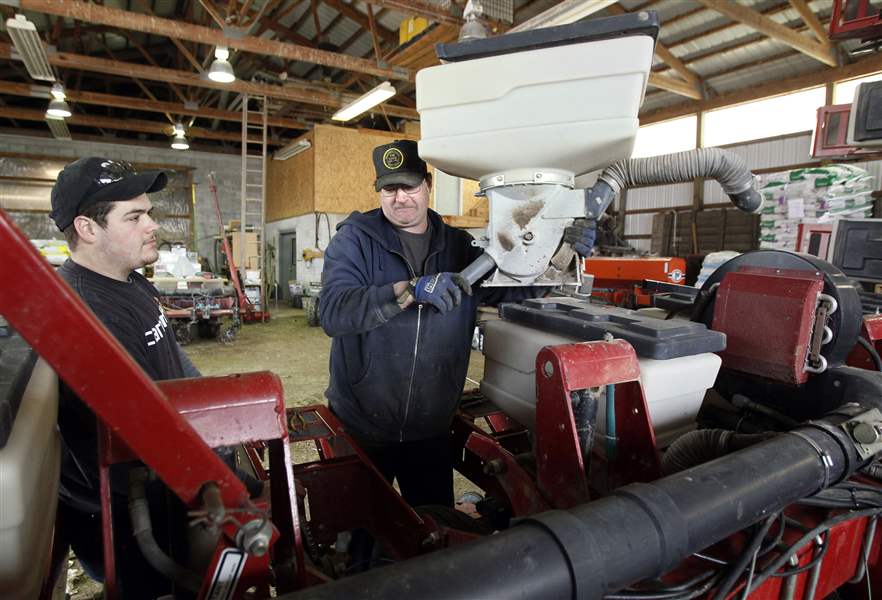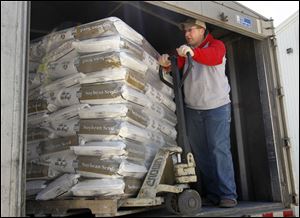
More farms pop for corn crop
4/17/2011
Bill Myers, right, and his son John Myers work on their corn planter in Oregon, Ohio. Mr. Myers says he'll increas corn production by 15 percent to 20 percent because he cut back last year.
The Blade/Jeremy Wadsworth
Buy This Image

Bill Myers, right, and his son John Myers work on their corn planter in Oregon, Ohio. Mr. Myers says he'll increas corn production by 15 percent to 20 percent because he cut back last year.
It remains too cold and wet to plant now, but in a few weeks when this year's spring crop goes to ground Ohio farmers will help increase the nation's corn acres to a level seen only once since World War II.
Dwindling supplies and increasing demand from ethanol producers have helped commodity prices soar to $8 a bushel, tempting farmers nationwide into plans to plant a 2011 corn crop of 92.2 million acres -- the second biggest planting since 1944 behind 2007's 93.5 million acres.
Ohio farmers expect to plant 3.7 million acres of corn, up from 3.45 million last year and the highest number of corn acres since 1994, according to U.S. Department of Agriculture estimates.
The statewide plan to plant more corn means farmers intend to plant 200,000 fewer acres of soybeans.
Michigan corn growers expect to plant 2.5 million acres of corn, up 100,000 acres or 4 percent from 2010.
Bill Myers, who farms in the Toledo suburb of Oregon with his brother Bob, said they plan to increase corn acres by 15 to 20 percent from last year. But that's because they decreased corn acres last year and now are returning to their typical rotation.
They are enjoying today's higher corn prices. "We run the numbers every year. Corn will be good," Mr. Myers predicted.
On the commodity markets a year ago, corn sold at $3.50 a bushel, less than half what it is today; soybeans selling now at $13.25 a bushel sold a year ago at $9.80; and wheat selling now for $7.30 sold a year ago for $4.70.
Nevertheless, many Ohio farmers, plan to divide up their acres between corn, soybeans, wheat and other crops much the way they usually do -- even if it means forgoing what appears to be an extra payout by adding more corn.
"It's tempting. But there's money to be made in soybeans, too, as far as that goes," said George Schramm of Columbus Grove in southern Putnam County.

Lavon Herschberger loads a truck with feed corn seed at Rupp Seed in Wauseon, Ohio, to distribute to area farmers getting ready for corn crop planting.
"It's a bigger deal to go back to more corn … a little more risky, a little more costly."
Corn is a more expensive crop to plant than soybeans.
"I think most of the farmers in this area are on the same page with that," he added.
But if the opportunity presents itself, some farmers are opting to plant more corn.
Dave Warner, a farmer near Vickery in Erie County, will plant 900 acres of corn this year, up from 820 last year. The decision purely was "price-driven," he said.
"Corn prices are good. And we've got the capabilities to do it," Mr. Warner said.
To add more corn, Mr. Warner is converting 40 acres he used for wheat and soybeans, and he acquired 40 acres. But he added that he wasn't about to go crazy on corn.
"We don't make big swings in our acreage," he said.
While many area farmers say they are not increasing corn production much, the tilt is toward more corn overall in northwest Ohio.
Mark Koenig, an agricultural agent with the Ohio State University extension service in Sandusky County, said he took a survey in February of county farmers. About 35 percent planned to plant more corn, 65 percent about the same amount, and just 3 percent less.
"Corn has a really good market here and you're kind of blessed in this area for corn. You've got the river, you're got big ethanol plants nearby, and you've got the rail," Mr. Koenig said.
At seed supplier Rupp Seeds Inc. in Fulton County, general manager of grain operations John King said sales reflect an intention by farmers of adding more corn. "Our corn sales are up significantly and soybean sales are up just slightly," he said.
If there is decent weather until mid-May, he said, there likely will be 10 to 20 percent more corn planted.
He added: "Obviously it costs more per acre to plant corn, but the potential reward of a big crop makes it worth the risk for some."
Matt Roberts, an agricultural economist at Ohio State University, said the chances of a farmer scrapping soybean or wheat acres and planting corn exclusively is slim in Ohio, but likely in Iowa, Illinois, Minnesota, and other Western farm states because their soil can better sustain a lack of crop rotation.
So thus far, for example, 500,000 more acres of corn is being planted in Iowa, 850,000 more in South Dakota, and 450,000 more in North Dakota. By comparison, only 250,000 more will be planted in Ohio. That means a given farm in Ohio might plant 30 or 50 acres more in corn, Mr. Roberts said.
Although corn prices look temptingly high, the relatively high price of soybeans and wheat makes keeping a rotation intact more palatable to Ohio farmers, he said.
"Last year we had a couple hundred acres of corn that didn't get planted because of the wet weather. So we planted a wheat crop earlier this year on those acres," Don Kunkle, a farmer near Alvordton in Williams County, said. "The wheat is good and beans was an excellent crop last year, so we're keeping our rotation about the same."
Likewise for Gordon Wenig, who farms land with his brother Phil near Haskins in Wood County, said what happened last year is affecting planting this year. "Wheat prices were high last fall so a lot of people committed to wheat last fall. You've only got so many acres and you can't increase [corn] if you don't have the acres to do so," Gordon Wenig said.
In Michigan, farmer Dick Heffelfinger of Reading in Hillsdale County, said he thought about the higher corn prices briefly but decided keeping his rotation between corn and soybeans was more important. It helps keep the soil fertile and fights plant diseases.
"To me, it's not worth chasing corn. Bean prices are pretty lucrative," he said. "When you start jumping around you can get into trouble.
Doug Darling of Maybee in Monroe County, also questioned abandoning beans or wheat. Last year, he said, he invested in a big corn crop and got burned as wet weather through May and early June kept him from planting it.
"Yes, corn prices look really good and soybean prices look really good," Mr. Darling said. "But if there's one thing we've learned is that high commodity prices can sometimes bring low commodity prices. The world changes quickly and if there's one bushel more than the [commodity] market needs, they won't pay for it."
Contact Jon Chavez at: jchavez@theblade.com or 419-724-6128.